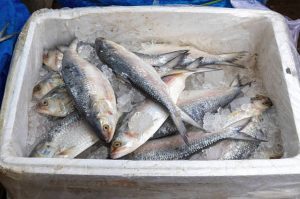No Padma Hilsa This Year: For years, the arrival of Hilsa from Bangladesh’s Padma River has marked the beginning of monsoon festivities in Bengal. This prized fish, known for its rich flavor and cultural symbolism, was once a staple on Bengali dinner tables. But this year, for the first time in over a decade, Kolkata’s fish markets are virtually devoid of Padma Hilsa, with buyers turning to alternatives from Myanmar and Gujarat due to rising costs, political constraints, and supply chain issues.
The change has sent ripples through Bengal’s food culture — with both nostalgia and pragmatism shaping the shift.

No Padma Hilsa This Year: Why the Padma Hilsa is Missing
The famed Padma Hilsa (Tenualosa ilisha), sourced from Bangladesh’s Padma River, is traditionally smuggled in or imported in limited quantities around Eid and Durga Puja. However, multiple factors have blocked its entry in 2025:
- Bangladesh’s Government Ban: Bangladesh continues to restrict Hilsa exports to India during key local religious festivals to ensure domestic supply. The quota-based permission system has become more infrequent since 2021.
→ Reference – Ministry of Fisheries, Bangladesh - Political Tensions: Strained India-Bangladesh diplomatic relations over Teesta water-sharing and border fencing have further limited trade permissions for delicacies like Hilsa.
→ Ministry of External Affairs – India - High Prices: The cost of Padma Hilsa, when available, ranges between ₹2,000–₹2,500 per kg — unaffordable for the average household, especially in the post-pandemic inflation scenario.
→ Department of Consumer Affairs, India
Kolkata Turns to Myanmar and Gujarat
In response to this vacuum, fishermen from Gujarat’s Narmada and Tapi river systems and suppliers from the Ayeyarwady Delta in Myanmar have filled the void. These fish, although similar in appearance, lack the same aroma and taste as the Padma Hilsa, but they come at a much lower cost.
- Myanmar Hilsa: Sold at ₹1,000–₹1,200 per kg. Slightly oilier and less bony, but lacks the signature taste.
- Gujarat Hilsa: Riverine fish, smaller in size (500g–800g), selling at ₹600–₹900 per kg. Fresh but mild in flavor.
Local fish vendors say that nearly 60–70% of Hilsa sales this season are sourced from these two regions. While some connoisseurs express disappointment, many middle-class households are embracing the compromise.
Market Response in Kolkata
At Gariahat, Manicktala, and Lake Market, long-time sellers have reported a dramatic drop in queries for Padma Hilsa. According to Shyamal Ghosh, a seller at Manicktala:
“People are not even asking for Padma ilish this year. They know it’s either too costly or unavailable. Myanmar and Gujarat fish are selling like hot cakes.”
This sentiment was echoed at Howrah Wholesale Market, where vendors say they are receiving bulk supplies from Gujarat ports, transported via refrigerated trucks.
Cultural Implications: Loss or Adaptation?
The absence of Padma Hilsa has also raised questions around cultural identity and food nostalgia. The Hilsa is more than a fish in Bengal — it is poetry, celebration, and ritual.
From Rabindranath Tagore’s verses to Durga Puja bhog menus, the ilish is a deep cultural symbol. The move away from Padma Hilsa is, for some, a painful break from heritage.
However, chefs across Kolkata are innovating. Hilsa biryani with Gujarat fish, Hilsa curry using frozen Bangladeshi stock, and fusion dishes with mustard and coconut are emerging in home kitchens and restaurants.
Environmental and Supply Chain Realities
The changing preferences are also a byproduct of ecological and logistical changes:
- Overfishing in the Padma River and climate disruptions have significantly reduced the population of mature Hilsa.
→ FAO – Global Hilsa Status Report - India’s inland Hilsa breeding programs in Odisha and Andhra Pradesh have not yet produced commercially viable quantities of high-quality fish.
- Myanmar, seeing a market opportunity, has ramped up exports with controlled aquaculture systems that mimic riverine conditions.
Expert View
Dr. Supratim Chatterjee, Professor of Fisheries Science at West Bengal University of Animal & Fishery Sciences, explains:
“The current Hilsa market in Kolkata is a reflection of global trade realignment and regional diplomacy. Bangladesh’s hold on Padma Hilsa will not be relaxed easily, and Kolkata’s dependence on foreign or west coast sources will continue unless we invest heavily in riverine aquaculture domestically.”
Government Stance and Next Steps
The West Bengal Fisheries Department has acknowledged the issue but hasn’t issued any policy changes for 2025. Officials claim that talks with Bangladesh are ongoing to allow a limited quota of Hilsa during Durga Puja.
Meanwhile, the Ministry of Commerce and Industry has encouraged fish importers to establish cold-chain logistics for fish from the east coast of India and Myanmar.
→ Directorate General of Foreign Trade – India
Conclusion: Will Padma Hilsa Return to Bengal Plates?
For now, Kolkata’s love affair with Hilsa is forced into new territory — one where the Padma river’s prized catch is no longer the reigning monarch. But Bengal’s ingenuity with food, its deep respect for tradition, and an adaptive market show that even without Padma Hilsa, the culinary spirit of ilish lives on — just with a different passport.
Also read: Home | Channel 6 Network – Latest News, Breaking Updates: Politics, Business, Tech & More

